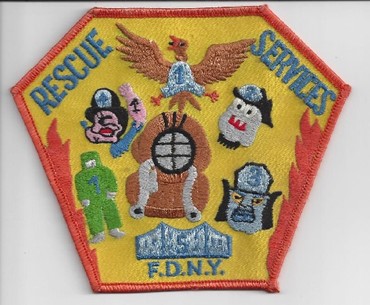

Prior to 1984 and for the longest time there only existed the 4 Rescue Companies. While other special units existed, these 4 were the most easily recognized and identified. These companies did an excellent job not only at fires but also at a number of other skills and disciplines that were becoming more necessary to be performed by the FDNY. During the late 1970’s and early 1980’s. It was becoming more apparent that these units needed to be augmented because of two very clear recurring problems. 1st and foremost was that Rescue 2 was being drawn out of Brooklyn to respond to calls in Staten Island thereby leaving the Borough of Brooklyn without a Rescue Company. The 2nd problem was a similar one with Rescue 4 leaving Queens to respond to hazardous materials incidents City-Wide; this sometimes required the long operational time periods where Queens was without its assigned Rescue Company. To solve both of these problems; it was decided to create 2 additional units so that both Rescues 2 & 4 could spend more time in their respective boroughs.
On 9/22/1984 two new units were created to solve the problem. Rescue 5 was created to handle Rescue Fire Duty issues in Staten Island. Hazardous Material Company 1 would be created to address hazardous materials incidents city-wide. This Unit was going to be different in many ways which will be discussed at length in another article; but one main difference from all other FDNY Fire Companies was its staffing. Up to this point all NYC fire companies were staffed with one (1) captain, three (3) lieutenants and twenty five (25) firefighters. Haz-Mat 1’s staffing would differ in firefighter strength, it would have 35 firefighters assigned. In addition a short time later this company was also assigned an administrative officer. With the five (5) Rescue Companies and the one (1) Haz-Mat this would become the original Rescue Services and was so designated under the command of BC Raymond Brown.
As time march on, many issues started to arise, this required expansion of the Rescue Services Battalion. Since all of these units were required to attain specialized training & skills as well as the equipment to perform these duties (diving operations, collapse operations, high angle operations & Haz-Mat operations) that seemed to be multiplying on a steady basis, a large logistics section had to be created to support such operations. Back in early years when Rescue Services first existed there were so many things that were new, there was also a lot of unchartered territory. Although the department was very good and well trained and disciplined in fires and rescue of all types, things were changing.
New Laws & Regulations were pushing the department into unfamiliar areas where years of fire expertise were not going to help them. One consequence was that now at some levels, with specialization, Chief Officers would have to rely on advice from subordinates who were more trained in these areas of specialization. Some of these disciplines included but were not limited to Diving Operations, Collapse operations, high Angle Rescue, Haz-Mat Operations, rigging and Urban Search & Rescue. Protective clothing was also changing; ¾ length coats & boots were being replaced with bunker gear, SCBA’s improved (½ hours bottles were being replaced with 45 min. and 1 hour bottles) and new tools and equipment were constantly being introduced on a regular basis. This included cell phones, on-board computers and thermal imaging cameras. The command was growing rapidly and had gotten to the point where the command was divided into Rescue Operations & Haz-Mat Operations. When Howard Safer was the Fire Commissioner both the Rescues and Haz-Mat were given their own respective battalions where chief officers were assigned to manage both areas. Rescue Operations were managed by Ray Downey & Tom Haring managed Haz-Mat Operations.


